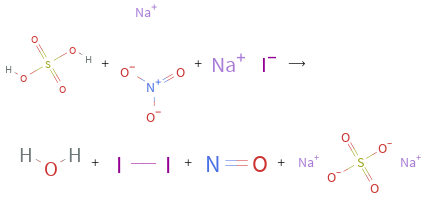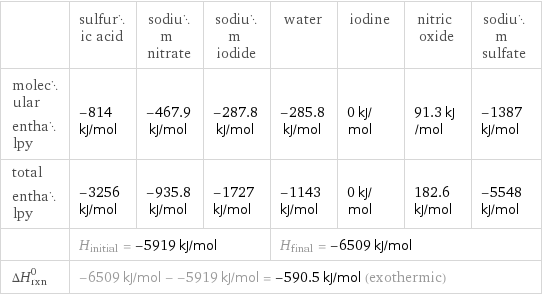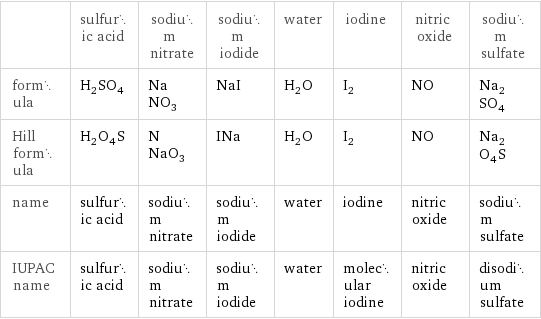Input interpretation

H_2SO_4 sulfuric acid + NaNO_3 sodium nitrate + NaI sodium iodide ⟶ H_2O water + I_2 iodine + NO nitric oxide + Na_2SO_4 sodium sulfate
Balanced equation

Balance the chemical equation algebraically: H_2SO_4 + NaNO_3 + NaI ⟶ H_2O + I_2 + NO + Na_2SO_4 Add stoichiometric coefficients, c_i, to the reactants and products: c_1 H_2SO_4 + c_2 NaNO_3 + c_3 NaI ⟶ c_4 H_2O + c_5 I_2 + c_6 NO + c_7 Na_2SO_4 Set the number of atoms in the reactants equal to the number of atoms in the products for H, O, S, N, Na and I: H: | 2 c_1 = 2 c_4 O: | 4 c_1 + 3 c_2 = c_4 + c_6 + 4 c_7 S: | c_1 = c_7 N: | c_2 = c_6 Na: | c_2 + c_3 = 2 c_7 I: | c_3 = 2 c_5 Since the coefficients are relative quantities and underdetermined, choose a coefficient to set arbitrarily. To keep the coefficients small, the arbitrary value is ordinarily one. For instance, set c_2 = 1 and solve the system of equations for the remaining coefficients: c_1 = 2 c_2 = 1 c_3 = 3 c_4 = 2 c_5 = 3/2 c_6 = 1 c_7 = 2 Multiply by the least common denominator, 2, to eliminate fractional coefficients: c_1 = 4 c_2 = 2 c_3 = 6 c_4 = 4 c_5 = 3 c_6 = 2 c_7 = 4 Substitute the coefficients into the chemical reaction to obtain the balanced equation: Answer: | | 4 H_2SO_4 + 2 NaNO_3 + 6 NaI ⟶ 4 H_2O + 3 I_2 + 2 NO + 4 Na_2SO_4
Structures

+ + ⟶ + + +
Names

sulfuric acid + sodium nitrate + sodium iodide ⟶ water + iodine + nitric oxide + sodium sulfate
Reaction thermodynamics
Enthalpy

| sulfuric acid | sodium nitrate | sodium iodide | water | iodine | nitric oxide | sodium sulfate molecular enthalpy | -814 kJ/mol | -467.9 kJ/mol | -287.8 kJ/mol | -285.8 kJ/mol | 0 kJ/mol | 91.3 kJ/mol | -1387 kJ/mol total enthalpy | -3256 kJ/mol | -935.8 kJ/mol | -1727 kJ/mol | -1143 kJ/mol | 0 kJ/mol | 182.6 kJ/mol | -5548 kJ/mol | H_initial = -5919 kJ/mol | | | H_final = -6509 kJ/mol | | | ΔH_rxn^0 | -6509 kJ/mol - -5919 kJ/mol = -590.5 kJ/mol (exothermic) | | | | | |
Gibbs free energy

| sulfuric acid | sodium nitrate | sodium iodide | water | iodine | nitric oxide | sodium sulfate molecular free energy | -690 kJ/mol | -366 kJ/mol | -286.1 kJ/mol | -237.1 kJ/mol | 0 kJ/mol | 87.6 kJ/mol | -1270 kJ/mol total free energy | -2760 kJ/mol | -732 kJ/mol | -1717 kJ/mol | -948.4 kJ/mol | 0 kJ/mol | 175.2 kJ/mol | -5081 kJ/mol | G_initial = -5209 kJ/mol | | | G_final = -5854 kJ/mol | | | ΔG_rxn^0 | -5854 kJ/mol - -5209 kJ/mol = -645.4 kJ/mol (exergonic) | | | | | |
Equilibrium constant
![Construct the equilibrium constant, K, expression for: H_2SO_4 + NaNO_3 + NaI ⟶ H_2O + I_2 + NO + Na_2SO_4 Plan: • Balance the chemical equation. • Determine the stoichiometric numbers. • Assemble the activity expression for each chemical species. • Use the activity expressions to build the equilibrium constant expression. Write the balanced chemical equation: 4 H_2SO_4 + 2 NaNO_3 + 6 NaI ⟶ 4 H_2O + 3 I_2 + 2 NO + 4 Na_2SO_4 Assign stoichiometric numbers, ν_i, using the stoichiometric coefficients, c_i, from the balanced chemical equation in the following manner: ν_i = -c_i for reactants and ν_i = c_i for products: chemical species | c_i | ν_i H_2SO_4 | 4 | -4 NaNO_3 | 2 | -2 NaI | 6 | -6 H_2O | 4 | 4 I_2 | 3 | 3 NO | 2 | 2 Na_2SO_4 | 4 | 4 Assemble the activity expressions accounting for the state of matter and ν_i: chemical species | c_i | ν_i | activity expression H_2SO_4 | 4 | -4 | ([H2SO4])^(-4) NaNO_3 | 2 | -2 | ([NaNO3])^(-2) NaI | 6 | -6 | ([NaI])^(-6) H_2O | 4 | 4 | ([H2O])^4 I_2 | 3 | 3 | ([I2])^3 NO | 2 | 2 | ([NO])^2 Na_2SO_4 | 4 | 4 | ([Na2SO4])^4 The equilibrium constant symbol in the concentration basis is: K_c Mulitply the activity expressions to arrive at the K_c expression: Answer: | | K_c = ([H2SO4])^(-4) ([NaNO3])^(-2) ([NaI])^(-6) ([H2O])^4 ([I2])^3 ([NO])^2 ([Na2SO4])^4 = (([H2O])^4 ([I2])^3 ([NO])^2 ([Na2SO4])^4)/(([H2SO4])^4 ([NaNO3])^2 ([NaI])^6)](../image_source/9a50c493d698b6c600573fca6940f436.png)
Construct the equilibrium constant, K, expression for: H_2SO_4 + NaNO_3 + NaI ⟶ H_2O + I_2 + NO + Na_2SO_4 Plan: • Balance the chemical equation. • Determine the stoichiometric numbers. • Assemble the activity expression for each chemical species. • Use the activity expressions to build the equilibrium constant expression. Write the balanced chemical equation: 4 H_2SO_4 + 2 NaNO_3 + 6 NaI ⟶ 4 H_2O + 3 I_2 + 2 NO + 4 Na_2SO_4 Assign stoichiometric numbers, ν_i, using the stoichiometric coefficients, c_i, from the balanced chemical equation in the following manner: ν_i = -c_i for reactants and ν_i = c_i for products: chemical species | c_i | ν_i H_2SO_4 | 4 | -4 NaNO_3 | 2 | -2 NaI | 6 | -6 H_2O | 4 | 4 I_2 | 3 | 3 NO | 2 | 2 Na_2SO_4 | 4 | 4 Assemble the activity expressions accounting for the state of matter and ν_i: chemical species | c_i | ν_i | activity expression H_2SO_4 | 4 | -4 | ([H2SO4])^(-4) NaNO_3 | 2 | -2 | ([NaNO3])^(-2) NaI | 6 | -6 | ([NaI])^(-6) H_2O | 4 | 4 | ([H2O])^4 I_2 | 3 | 3 | ([I2])^3 NO | 2 | 2 | ([NO])^2 Na_2SO_4 | 4 | 4 | ([Na2SO4])^4 The equilibrium constant symbol in the concentration basis is: K_c Mulitply the activity expressions to arrive at the K_c expression: Answer: | | K_c = ([H2SO4])^(-4) ([NaNO3])^(-2) ([NaI])^(-6) ([H2O])^4 ([I2])^3 ([NO])^2 ([Na2SO4])^4 = (([H2O])^4 ([I2])^3 ([NO])^2 ([Na2SO4])^4)/(([H2SO4])^4 ([NaNO3])^2 ([NaI])^6)
Rate of reaction
![Construct the rate of reaction expression for: H_2SO_4 + NaNO_3 + NaI ⟶ H_2O + I_2 + NO + Na_2SO_4 Plan: • Balance the chemical equation. • Determine the stoichiometric numbers. • Assemble the rate term for each chemical species. • Write the rate of reaction expression. Write the balanced chemical equation: 4 H_2SO_4 + 2 NaNO_3 + 6 NaI ⟶ 4 H_2O + 3 I_2 + 2 NO + 4 Na_2SO_4 Assign stoichiometric numbers, ν_i, using the stoichiometric coefficients, c_i, from the balanced chemical equation in the following manner: ν_i = -c_i for reactants and ν_i = c_i for products: chemical species | c_i | ν_i H_2SO_4 | 4 | -4 NaNO_3 | 2 | -2 NaI | 6 | -6 H_2O | 4 | 4 I_2 | 3 | 3 NO | 2 | 2 Na_2SO_4 | 4 | 4 The rate term for each chemical species, B_i, is 1/ν_i(Δ[B_i])/(Δt) where [B_i] is the amount concentration and t is time: chemical species | c_i | ν_i | rate term H_2SO_4 | 4 | -4 | -1/4 (Δ[H2SO4])/(Δt) NaNO_3 | 2 | -2 | -1/2 (Δ[NaNO3])/(Δt) NaI | 6 | -6 | -1/6 (Δ[NaI])/(Δt) H_2O | 4 | 4 | 1/4 (Δ[H2O])/(Δt) I_2 | 3 | 3 | 1/3 (Δ[I2])/(Δt) NO | 2 | 2 | 1/2 (Δ[NO])/(Δt) Na_2SO_4 | 4 | 4 | 1/4 (Δ[Na2SO4])/(Δt) (for infinitesimal rate of change, replace Δ with d) Set the rate terms equal to each other to arrive at the rate expression: Answer: | | rate = -1/4 (Δ[H2SO4])/(Δt) = -1/2 (Δ[NaNO3])/(Δt) = -1/6 (Δ[NaI])/(Δt) = 1/4 (Δ[H2O])/(Δt) = 1/3 (Δ[I2])/(Δt) = 1/2 (Δ[NO])/(Δt) = 1/4 (Δ[Na2SO4])/(Δt) (assuming constant volume and no accumulation of intermediates or side products)](../image_source/57d80589bf52394011ea53c67c4574a1.png)
Construct the rate of reaction expression for: H_2SO_4 + NaNO_3 + NaI ⟶ H_2O + I_2 + NO + Na_2SO_4 Plan: • Balance the chemical equation. • Determine the stoichiometric numbers. • Assemble the rate term for each chemical species. • Write the rate of reaction expression. Write the balanced chemical equation: 4 H_2SO_4 + 2 NaNO_3 + 6 NaI ⟶ 4 H_2O + 3 I_2 + 2 NO + 4 Na_2SO_4 Assign stoichiometric numbers, ν_i, using the stoichiometric coefficients, c_i, from the balanced chemical equation in the following manner: ν_i = -c_i for reactants and ν_i = c_i for products: chemical species | c_i | ν_i H_2SO_4 | 4 | -4 NaNO_3 | 2 | -2 NaI | 6 | -6 H_2O | 4 | 4 I_2 | 3 | 3 NO | 2 | 2 Na_2SO_4 | 4 | 4 The rate term for each chemical species, B_i, is 1/ν_i(Δ[B_i])/(Δt) where [B_i] is the amount concentration and t is time: chemical species | c_i | ν_i | rate term H_2SO_4 | 4 | -4 | -1/4 (Δ[H2SO4])/(Δt) NaNO_3 | 2 | -2 | -1/2 (Δ[NaNO3])/(Δt) NaI | 6 | -6 | -1/6 (Δ[NaI])/(Δt) H_2O | 4 | 4 | 1/4 (Δ[H2O])/(Δt) I_2 | 3 | 3 | 1/3 (Δ[I2])/(Δt) NO | 2 | 2 | 1/2 (Δ[NO])/(Δt) Na_2SO_4 | 4 | 4 | 1/4 (Δ[Na2SO4])/(Δt) (for infinitesimal rate of change, replace Δ with d) Set the rate terms equal to each other to arrive at the rate expression: Answer: | | rate = -1/4 (Δ[H2SO4])/(Δt) = -1/2 (Δ[NaNO3])/(Δt) = -1/6 (Δ[NaI])/(Δt) = 1/4 (Δ[H2O])/(Δt) = 1/3 (Δ[I2])/(Δt) = 1/2 (Δ[NO])/(Δt) = 1/4 (Δ[Na2SO4])/(Δt) (assuming constant volume and no accumulation of intermediates or side products)
Chemical names and formulas

| sulfuric acid | sodium nitrate | sodium iodide | water | iodine | nitric oxide | sodium sulfate formula | H_2SO_4 | NaNO_3 | NaI | H_2O | I_2 | NO | Na_2SO_4 Hill formula | H_2O_4S | NNaO_3 | INa | H_2O | I_2 | NO | Na_2O_4S name | sulfuric acid | sodium nitrate | sodium iodide | water | iodine | nitric oxide | sodium sulfate IUPAC name | sulfuric acid | sodium nitrate | sodium iodide | water | molecular iodine | nitric oxide | disodium sulfate